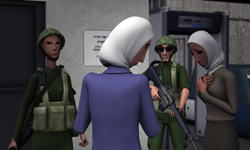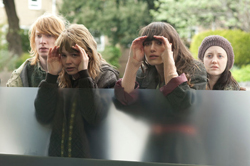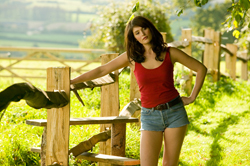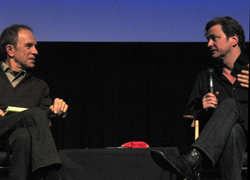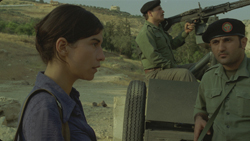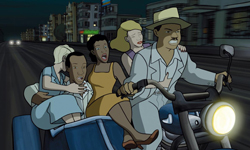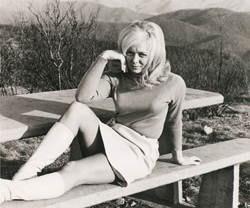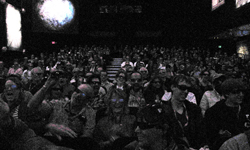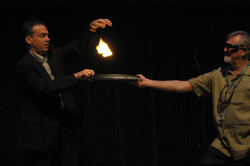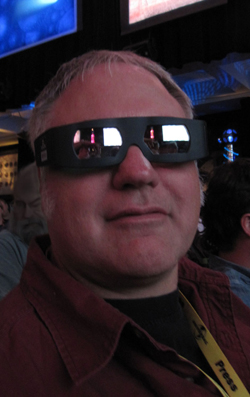Passes were nearly sold out at this year’s festival but getting around and getting into movies seemed a quite a bit easier than in past years. This might have been dumb luck or it might have been that a bunch of people were trying to see James Franco in person at screenings of 127 Hours. Usually we get five movies per day. Six is the theoretical maximum for a day at Telluride and even that has happened a couple of times in years past. This year it was only four per day (three on Friday). So the total films for us this year was 15 from Friday to Monday (Labor Day). That’s 15 time slots; three of those were filled with shorts programs. I love catching shorts at festivals. I haven’t tried this myself but I understand that iTunes carries many shorts these days. Maybe Netflix streaming will start to carry them. Getting into the movies was also surely made easier by the perfect 70 degree weather each day.
And this year we enjoyed a presentation by Serge Bromberg of Lobster Films on the past and present of 3D, which I have highlighted at the end of this report.
As mentioned about the festival happens over Labor Day and my shorthand description for Telluride is ‘Hollywood’s Labor Day Vacation’. Stars present at this year’s festival were: James Franco, Colin Firth (tributee), Lesley Manville, director Peter Wier (tributee), Ed Harris, Claudette Cardianale (tributee), Carey Mulligan, and Geoffry Rush. Also present were directors Danny Boyle, Darren Aronofsky. Werner Hertzog, and as always, Ken Burns.
The big news at Telluride for us techies is that digital has arrived for good. Last year there were one or two major films projected digitally and a couple of smaller theaters that were all digital. Those theaters remains but each of the 4 large auditoriums was equipped for regular film projection or digital projection using Barco projectors and a Dolby Digital Server. This change was brought about by the filmmakers themselves. If they shot it digitally they wanted to show it digitally. Or, at least they did not want to pay for the expense of having it transferred to film. The digital films were stored on Dolby Digital Cinema Servers and projected with Barco projectors. We tried to get some photos of these big projectors in action but the busy film schedule and general reluctance to let extraneous people into the projection booths prevented this. Of the 12 feature films we saw I think nearly all of them were projected digitally. This came in quite handy when during the showing of The King’s Speech when a man near the front was overcome by a seizure. Eventually the audience cries to stop the film were heard and the film was stopped and backed up before our eyes. The man was eventually helped by paramedics.
That bit of audience trauma was on the heels of some more noteworthy incidents during screenings of Danny Boyle’s 127 Hours. One viewer passed out, another had a panic attack. A testament to the power of film. 127 Hours is the dramatization of the ordeal of hiker Aron Ralston (who was also present at the festival). If you’re not familiar with the story Mr. Ralston was hiking a narrow slot canyon in Utah when he got his arm pinned by a large boulder. After some time (127 hours I’m guessing) he freed himself by cutting his arm off at the elbow. Ok, we can see how that’s not easy to watch, especially as presented by Danny Boyle (Trainspotting, 28 Days Later).
This film was shown as a ‘Sneak Preview’ because it is due out in theaters in November.
The film with the biggest controversy however was the French film Of Gods and Men though the controversy went largely unnoticed at Telluride. In France, president Nicolas Sarkozy asked that the French premier of the film be delayed so that he could see it and prepare his remarks about it before it was seen by a wide audience. I didn’t get to see it but the basic plot is that French monks in a Catholic monastery in Algeria have to decide whether to stay or go back to France when threatened by Islamic extremists.
Shorts were of better quality than in previous years and I want to give special mention to a few of them in case you are able to find them online somewhere (use your google)…
Fatenah: animated, a woman with breast cancer struggles to get across a border checkpoint to get to a hospital for treatment.
Off Season: A big budget short but part of the student program. Actor Bill Sage (High Art, and many Hal Hartley films). This is as good as horror movie as you could wish to see.
God of Love: A man’s constant prayers to get some help in winning the affections of the one he loves wins a response from ‘Olympus Group’.
Poster Girl: Documentary about an Iraqi war vet. Highly recommended.
The feature films we did see in no particular order
NEVER LET ME GO
A science fiction film but not a special effects movie. In fact it is set the 70’s, 80’s and 90’s with only minimal techy embellishment. Based on Kazuo Ishiguro’s novel which Time magazine called the best of the decade, the movie follows the lives of children raised together at an English boarding school. Not an ordinary boarding school of course. These children are being raised for a special purpose which is actually revealed fairly early on and in most of the reviews I’ve heard. The movie doesn’t rely on revelations or plot twists or even on any Sci-fi gadgetry, it’s more an attempt to get you to think. Starring Keira Knightley and Carey Mulligan and a haunting music score. Carey Mulligan is once again entirely enchanting and the movie is carried on her face. The film leaves out some details that a book could easily cover or expound upon and will probably leave some viewers scratching their heads. But if you accept that the facts are as they are presented and look at the larger question being asked, the film is a beautiful meditation on what it means to live as part of a group. This one will stick with you long after you see it.
TAMARA DREWE
Based on a graphic novel of the same name which itself was simply the compilation of comic strips that appeared in the Guardian. These strips were regarded as a commentary on contemporary British society. I finished reading the novel just before the festival so my own interest in the movie was as much to see how they handled the conversion as for the story itself. I recommend the same exercise to you. The movie and the novel are entertaining enough but since the movie was cast with actors with striking resemblance to their graphic-novel avatars it’s a really fun experience to watch your mental pictures come to life. There are a couple of deviations from the story line but both versions are fun. The story revolves around a writer’s retreat set in the English country side and young woman who returns to handle her mother’s estate after living and writing in London.
THE KING’S SPEECH
I can’t fault a movie for being heartwarming if it’s a true story. A very dramatic but small part of the story of WWII, in the lead up to the war the English throne was passed from King George the V to King Edward VIII and then quickly to King George the VI who, though younger, was considered by all to be better suited for the serious times that lie ahead. Even though the King of England was the titular leader of 35% of the world’s population at that time he was as now mostly a figurehead. Still, in a time of war he was relied upon to rally the nation. One small problem, King George the VI was a stutterer since childhood. Geoffrey Rush was a producer on the film and plays brilliantly the unorthodox speech therapist, who was way ahead of his time. Colin Firth plays the king and will certainly receive an Oscar nomination. These two together are something special. Oscar noms for both. Most in the audience were crying at various points, a three hanky movie.
INCENDIES
‘Incendies’ is French for ‘fire’. This one will stick with you. Incendies is the story of a young woman whose life is turned upside-down by the Lebanese civil war of 1970’s. When she dies of old age in Quebec her will sends her two children on a journey to her homeland that reveals the riveting story of her early days. The film is expertly crafted and the acting is superb. It is about a war and there are many moments that are hard to take but the stunning heart of the movie is that it presents the best of humanity wrapped around the worst. The music of Radiohead is used throughout and even though we all knew this music was haunting and among the best music of our time, when it’s paired with these images it reaches new depths.
ANOTHER YEAR
The latest from Mike Leigh, using his usual crew of actors including Leslie Manville who was present at the screening. Mr. Leigh works out the script along with the actors over a long period. Filming is done in sequence and the story is revealed to the actors only as it happens in the sequence. This method worked against the film somewhat in the opening scenes as some of the lines were delivered rather flat but this is long forgotten by the time the film hits its stride. Manville plays Mary, middle-aged, lonely and alcoholic. A couple that she is connected to through work has a habit of picking up and nurturing strays. For them it is a simple extension to their nurturing nature but friends are not family. There is a limit. The method of film making and caliber of the acting makes for an extremely realistic portrait of real life and the problems that many people carry for life. For the actors and for us the story is filled in as we go along.
Leslie Manville stayed for an extensive Q&A after the screening. She called attention to the final shot which was an extended continuous shot slowly circling a dinner table. Leslie said that she wasn’t aware that the movie was about her character until this final scene.
PRECIOUS LIFE
Produced by Ehud Bleiberg, this film walks the same territory as The Band’s Visit. The 2007 film which he also produced and also played at Telluride. In this case however it’s Israel-Gaza rather than Israel-Egypt and it’s all real, not fiction. Not surprisingly, hospital services in Gaza are a little thin so for a couple with a child born with immune-deficiency (a malady which up until recently meant being confined to a plastic bubble), frequent journey’s to hospital in Israel are required. And that’s just the beginning. Each of these journey’s requires crossing the border. The film doesn’t dwell on the border crossings but actually they are the key that allows the medical treatment to proceed. It is only the in-depth attention of an Israeli TV reporter (who made the film) that lets the crossings proceed.
The animated short film, Fatenah, which was also playing at the festival, is the story of a Gaza woman with breast cancer who doesn’t fare as well. The real-life attempts shown in Precious Life look even worse at first as we see a bullet fired into an ambulance. This film is a great chance to see Israelis and Palestinians actually discussing their differences though the societal pressures are also in evidence. I was most saddened, however, when I heared the reporter/director say during the Q&A that many Israeli’s upon seeing this film began to see Palestinians simply as people for the first time. Struggling, (mightily) rather than as some inhuman enemy. Yes it’s great that they’re making this breakthrough, I just thought we were already well past that.
CHICO AND RITA
An animated melodrama propelled by Cuban jazz. The story follows Chico and Rita as young Cubans who meet in the early days of Jazz. Their career and relationship are dictated by the cultural, economic and political tides of the 20th century. One of the directors of the festival called this the most beautiful movie he’d ever seen. The animation and story are beautiful but it really is the music that makes this one. The end of the credits have the typical disclaimer about ‘any resemblance to actual persons is completely coincidental blah blah..’ but since much of the music is composed by Bebo Valdés and since the character Chico resembles him and was born at about the right time…
TABLOID
This is the latest documentary from the master Errol Morris. I found it hard to get into this one at first because the last two films by Mr. Morris’ were of such monumental importance. The Fog of War about Robert McNamara and the Vietnam war debuted at the 2003 Telluride Festival and Standard Operating Procedure [2008] was about Abu Ghraib torture. Well I’m sure Morris felt like he needed a break after all that. Tabloid is about a long forgotten tabloid queen Joyce McKinney. A former Miss Wyoming, Ms. McKinney is quoted in the film saying ‘I didn’t really understand how big the world was until I went to Utah’. In Utah she fell in love with a young Mormon and her world got even bigger. Of course the proper approvals for this couple were not forthcoming and the Mormon church saw fit to send her beau to London when it came time for his ‘Mission’. Pursuit(s) follow. At times I felt bad watching this which largely seems to draw laughs at the expense of McKinney who, though able to speak well for herself at times, may be certifiably insane. In the Q&A Morris said that he loves everyone in his movies and he said that in this case he thinks they (McKinney, tabloid reporters, the Mormons) are all crazy.
INSIDE JOB
Another documentary, this one by Charles Ferguson (No End In Sight, Oscar nominated doc about the Iraq war) is about the Wall Street fueled economic crash of our times. If you are familiar with the story you might not learn much through the first half of the movie but the sharp graphics and aerial shots of Manhattan will have you admiring your home theater, or thinking about it if you happen to see this in a theater. The second half though breaks some new ground with interviews with culpable parties who far from showing remorse seem blissfully unaware of the issues and their part in it. In the Q&A Ferguson reasoned that it was his own conservative-looking credentials and even friendships with these people that allowed him to gain access but when his questions were anything but softball, some of those friendships were over.
Back on the technical front for a minute (yes the economy is destroyed but we love our movies). This film was of course shot digitally. It was also projected digitally. I have never seen images so large be so sharp. When dramas are shot digitally they are processed to look more film-like for projection. I think we will begin to see that process gradually fade away at least for some films. It will take some getting used to but should be interesting.
POETRY
Director Lee Chang-dong was at Telluride in 2003 with Secret Sunshine. Of all the people I know who saw that film I’m the only one who liked it. Loved it actually. While the story was definitely hard to take, a woman grieving over her lost family, the unobtrusive commentary on Korean society and subtle allusions to how we should connect with the earth in such circumstances had me enthralled. In Poetry we again have a woman, very much on her own, and not finding much to like in modern Korean society. This one will go down easier with most people as there are no protracted crying scenes and there is a bit more plot to latch onto. The straightforward, realistic presentation of the people revolving around the main character is the filmmaking that wins this director slots at Telluride. It took me a while to come up with a directing style similar to this and I think I finally have it, John Sayles, especially Lone Star.
THE ILLUSIONIST
Animated, based on a script by Jacques Tati and animated by Sylvain Chomey (Triplets of Belleville). A couple of years ago Tati’s Playtime was shown at Telluride from a 70mm print. I suspect the print was what was used to make the Criterion Collection DVD for Playtime. At that showing the audience was rolling in the aisles. The Illusionist was very much of the same ilk as Playtime but this time the audience was not getting it. I should not that I’ve had the same experience with small audiences at my house when I show them the Playtime DVD. You sorta-havta be in the mood for these. The animation and story are sweet nonetheless but there is no actual dialogue, just the occasional grunt or word so you have pay attention. The jokes are often in the background and somewhat bittersweet actually as the story here is of a vaudeville magician who is no longer appreciated by the modern world. The funniest part is one of the acts that is replacing our hero is a rather silly rock band, a compendium of rock band clichés on stage and something else entirely off stage. I found it interesting that this animated band was remarkably similar to the one in Tamara Drewe. There often seem to be odd repeating themes at film festivals. The Illusionist is definitely recommended for fans of Tati or Chomey, everyone else consider carefully.
3D PAST AND PRESENT AT TELLURIDE
This was a special Telluride presentation by Serge Bromberg of Lobster Films: RETOUR DE FLAMME IN 3D. Serge is a film collector and archivist; he had a presentation in the 2009 festival of a selection from his archive. He returned this year with a 100 minute presentation about the past and present of 3D. But not without first demonstrating the flammability of traditional Nitrate based film stock.
Nitrate has long since been replaced with ‘Safety’ film which is not only less flammable but doesn’t shrink or decay at the alarming rate of Nitrate film. And of course, now both are replaced by digital. Even for this presentation Bromberg elected to have all of the original films he was presenting converted to digital. The top-of-the-line Barco DP2K-32B was used in this theater, specifically to provide sufficient brightness for the 3D presentation to a 500 person audience. This projector provides 33000 lumens, we were not left wanting. It is a single lens projector though, the 3D effect was provided by Dolby with their Dolby 3D technology which uses a color wheel inside (not in front of) the projector and dichroic filters (not polarized) in the glasses.
Simple enough right? Ok, if you’re like me you needed a little more explanation. The Dolby system is generically called ‘wavelength multiplexing’. Meaning, the information for the left eye is carried on one set of wavelengths, and the information on the right eye on another set. Each ‘set’ consists of red, green and blue but not the same red, green and blue as the other. If you are familiar with measurements and calibration for color TV’s, projectors, etc, you are familiar with the concept of the ‘color space’ and that a monitor from company A might have a slightly different version of ‘pure green’ than that from company B. The difference might not be enough for you to care but if you do happen to get your set calibrated you can enjoy more natural looking pictures. The point being for this discussion that what Dolby is doing here is taking advantage of the available color space and assigning one set of primary colors to the left eye and another to the right. If you were able to take all the steps necessary to isolate the left eye projections from the right eye projections (stop the picture and the color wheel inside the projector (yes there is a color wheel, more on that in a minute), take off your glasses and cover one eye at a time) you might be able to see the slightly different color meant for the left eye vs. the right. With your glasses on however you wouldn’t see the difference.
The glasses have 50 layers of dichroic filter. Dichroic refers to a manufacturing process for making very thin film capable of precise color filtering. By calibrating the projector with color wheel for both the left and right eye Dolby is able to recreate the intended color of the original material in magical, bright 3D. Note that the old-school, traditional method of 3D projection uses a polarizing filter in front of the projector, resulting in the dim, somewhat fuzzy images we all remember. My experience with the glasses was that they were completely comfortable. When the image was off I could tell that one eye (left I think) seemed much more heavily filtered (ie., darker) than the right. When the image was on it looked fantastic, all the way to the edges of the screen. When the movie was over, they wanted the glasses back. I’m guessing these are not cheap to make.
My primitive understanding of the 3D projector market is that Dolby’s system is bigger overseas while RealD’s system which uses circular polarizing lenses in the glasses and projects alternately polarized images (I think this is how we all saw Avatar), is bigger in the US. The cynic in me can see theater managers theorizing that Dolby’s eyeware is too expensive to replace and that they don’t trust their clientele to return them. I’m pretty cynical though. It’s a little unfair perhaps to compare any movie projected at Telluride with one shown at the mall because they really go all out at Telluride but I can tell you that I preferred the 3D I saw on this day to my previous experiences, even Avatar. It seemed to stretch to the corners of the screen better, not just one or two items in the foreground, and the glasses were more comfortable. I dutifully returned the glasses.
So will we see this Dolby system in our home projectors? Perhaps, but there is the matter of the color wheel. It goes inside the projector, so it’s not like you can add it on yourself. The nice thing is that it can be easily moved aside as well for regular 2D projection. Given that most people don’t have projectors at all I’m guessing that Dolby will come out with some other system that works on flat screen displays. It seems like the color wheel could be mimicked digitally with some heroic processing and a fast enough refresh rate on a digital monitor but I think the calibration step is also critical. If you left your monitor un-calibrated you might end up with some unsatisfactory colors when showing 3D with this system. That’s just my guess though. It’s a funny thing about Dolby, this system at its heart is similar to Dolby Noise Reduction that made the company famous back in the day. Dolby Noise Reduction (we just used to call it ‘Dolby’) shifts the level of the high to low frequencies recorded to the tape and then unshifts, or filters out the bias during playback so that the overall result has less noise. For this 3D system they shift the left eye information one way, the right eye information another and then filter them back (with the glasses) during playback so that the overall color experience is true to the original.
Enough technology though. What did they show us at Telluride? How about some 3D footage from 1900? That’s four years after the invention of cinema. About 10 minutes of 4 short scenes about a man’s visit to his girlfriend. Yes, there was some nudity and general frolicking. Do you think people will want 3D in their homes?? This original footage was shot at five frames per second and meant to be viewed with a stereoscopic viewer.
Moving on to 1902, Georges Méliès, who made over 500 films from 1896 to 1913 had a little problem with piracy. Some things never change. I will point out however that the movie industry survived. Méliès’ films were distributed worldwide but the problem was that there were a limited number of prints. Some of them would make their way to North America before the official release and dilute the audience. The solution was to shoot from two side by side cameras at the same time so that more prints could be made and released simultaneously. It was not known until recently that this tactic was used. It was discovered accidentally when Bromberg noticed that the angle was slightly different in two different prints of The Devil and the Statue.
The 1950’s were perhaps the hey-day of 3D but not just in the US. Russia had to keep up and we saw an enchanting 3D short shot underwater. This film was the one with the best 3D in my opinion, fish, sharks, right over my head.
There were a few other gems and interesting shorts. In the 1950’s Chrysler made a 3D animation of the construction of one of their cars. Cars were more simple then.
The program wrapped up with two new 3D cartoons from Pixar. Road Runner cartoons. I’m not sure if the ‘accidents’ befalling Wylie Coyote are more severe than when we were kids. I think it’s the 3D that made me feel so bad for Mr. Coyote.
If you happen to be going to Europe (or maybe you live there), I recommend a visit to the website for lobster films (http://www.lobsterfilms.com). You’ll see this interesting invitation: “If you are based in or around Paris, you can then contact our archivists to watch the selected images at our Paris offices soon after.” Monsieur Bromberg is very enthusiastic about and very generous with the amazing old images he has collected.
Photos of Telluride courtesy of Ray Keller and individual studios




